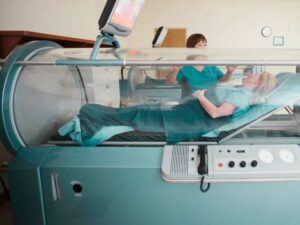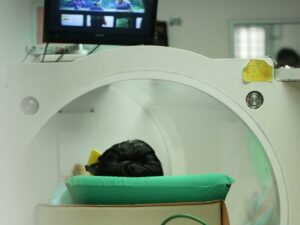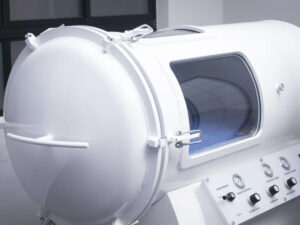How long does the effects of Hyperbaric Oxygen Therapy last? As a business owner or a healthcare provider, it’s crucial to understand the longevity of this treatment, not only to manage patient expectations but also to plan treatment sessions efficiently.
In this article, we aim to demystify the science behind HBOT and explore the effects of this therapy. With this knowledge, owners can make more informed decisions for their healthcare business and provide their patients with accurate information about this promising treatment modality.
Read on to enhance the understanding of hyperbaric oxygen therapy.
1. The Science Behind Hyperbaric Oxygen Therapy
Unlocking the principles of Hyperbaric Oxygen Therapy offers profound insight into its therapeutic potential. Here are some key elements that decipher its mechanism and importance.
The Role of Oxygen in Our Body
According to UCAR, oxygen plays a critical role in respiration, the energy-producing chemistry that drives the metabolisms of most living things. During this process, oxygen combines with glucose to generate adenosine triphosphate (ATP), the primary energy currency in living organisms. Moreover, oxygen contributes to the synthesis of various essential biological molecules.
How Hyperbaric Oxygen Therapy Works
Hyperbaric Oxygen Therapy operates on a simple yet powerful principle – supplying the body with a higher concentration of oxygen. During an HBOT session, patients inhale 100% oxygen within a pressurized chamber, usually set to a pressure exceeding one atmospheric pressure. At OxygenArk, the heightened pressure inside our hyperbaric chambers facilitates the dissolution of a higher volume of oxygen into the bloodstream.
Understanding Its Significance in Therapy
HBOT’s unique mechanism offers several therapeutic benefits, making it an invaluable tool for treating various conditions. It can prove particularly effective in managing diseases and conditions associated with decreased oxygen supply. In addition, the therapy can alleviate symptoms and enhance the healing process in conditions like carbon monoxide poisoning, sudden sensorineural hearing loss, and radiation injury to tissues.
Potential Applications in Future Research and Medicine
The therapeutic potential of HBOT is still being explored. Preliminary research suggests possible applications in neurology, with early studies indicating that HBOT might have a positive impact on conditions like traumatic brain injury and stroke. The therapy’s ability to improve oxygen supply to brain tissues and reduce inflammation may help in managing these conditions.
The Role of HBOT in Integrative Medicine
Integrative medicine emphasizes a holistic, patient-focused approach to healthcare, combining conventional Western medicine with complementary treatments. HBOT could be a valuable addition to this approach, enhancing the overall effectiveness of treatment plans. HBOT could potentially enhance the effectiveness of physical therapies and rehabilitation exercises in conditions like stroke or traumatic brain injury.
2. The Duration of Hyperbaric Oxygen Therapy Effects
Understanding the longevity of HBOT’s impacts sheds light on its effectiveness and scope. Here is an exploration of the immediate, short-term, and long-term effects of this therapy.
Immediate Effects of Hyperbaric Oxygen Therapy
The immediate effects of HBOT can be observed soon after the therapy session and can be quite encouraging for patients.
Benefits on Oxygen Saturation
One of the most immediate effects of Hyperbaric Oxygen Therapy is an increase in the oxygen saturation levels in the blood. During an HBOT session, patients inhale 100% oxygen at pressures greater than normal atmospheric pressure. This process enables a greater volume of oxygen to be dissolved in the bloodstream, thereby significantly boosting oxygen saturation.
The table below showcases the significant benefits of Hyperbaric Oxygen Therapy (HBOT) on oxygen saturation levels, highlighting its ability to rapidly increase blood oxygen saturation, enhance oxygen delivery to tissues and organs, promote tissue repair, reduce hypoxia, improve organ function, and boost the immune response for comprehensive health benefits.
| Benefits on Oxygen Saturation |
Description |
| Increased Blood Oxygen Saturation |
HBOT leads to a rapid increase in oxygen saturation levels in the blood. Inhaling 100% oxygen at higher pressures enables a greater volume of oxygen to dissolve in the bloodstream, resulting in significantly improved oxygen saturation. |
| Enhanced Oxygen Delivery |
The higher oxygen saturation levels facilitate enhanced oxygen delivery to tissues and organs throughout the body. This promotes cellular metabolism, tissue healing, and improved overall functioning. |
| Tissue Repair and Regeneration |
Improved oxygen saturation supports tissue repair and regeneration processes. The increased oxygen availability aids in the healing of wounds, injuries, and damaged tissues. |
| Reduced Hypoxia |
HBOT effectively reduces hypoxia, a condition characterized by low oxygen levels in tissues. The therapy helps counteract the effects of oxygen deficiency and prevents further tissue damage. |
| Improved Organ Function |
Elevated oxygen saturation benefits vital organs, such as the brain, heart, and lungs, by providing the necessary oxygen for optimal functioning and improved health. |
| Enhanced Immune Response |
Higher oxygen saturation levels stimulate the immune system, bolstering its ability to fight infections and diseases, thereby supporting the body’s overall healing process. |
Reduced Swelling and Inflammation
Hyperbaric Oxygen Therapy is also recognized for its potent anti-inflammatory effects. For instance, within a few hours of an HBOT session, patients often observe noticeable reductions in swelling and inflammation related to their specific condition. The high concentration of oxygen inhibits certain inflammation pathways, resulting in decreased production of pro-inflammatory cytokines.
Enhanced Healing of Wounds
Even within a few hours post-treatment, the effects of HBOT on wound healing can be observed. The oxygen-rich environment enhances the function of leukocytes, which fight infection, and promotes the formation of new blood vessels in the affected area. Patients with non-healing ulcers or post-operative wounds might notice reduced wound size, decreased discharge, and less pain shortly after starting their HBOT treatment.
Improved Cognitive Function
While this effect may not be universally immediate, certain patients, especially those undergoing HBOT for neurological conditions, may experience enhanced cognitive function shortly after their treatment session. This can translate into better concentration, improved memory, and enhanced cognitive clarity, even shortly after an HBOT session.
Short-Term Effects of Hyperbaric Oxygen Therapy
In addition to the immediate benefits, Hyperbaric Oxygen Therapy offers a range of short-term effects which usually emerge within the first few days to a week after the onset of treatment.
Accelerated Tissue Repair
In the short term, typically within the first week, patients might notice a significant acceleration in tissue repair. The oxygen boost enhances the body’s ability to regenerate damaged tissues by promoting collagen production, a vital protein for skin and tissue structure. It also optimizes the body’s response to inflammation and infection, creating an environment conducive for tissue repair and recovery.
Increased Energy Levels
Many patients report a significant increase in energy levels after undergoing a few sessions of HBOT. The heightened level of oxygen in the bloodstream facilitates more efficient energy production at the cellular level. This can result in the patient feeling more active, energetic, and less fatigued in their day-to-day life.
Enhanced Immune System Response
HBOT can bolster the immune system response, a benefit that becomes more evident within the first week of therapy. The increased oxygen supply helps in the better functioning of the white blood cells, enhancing their ability to fight infections. It also improves the body’s ability to produce antioxidants, further strengthening its defense against harmful pathogens.
Relief from Decompression Sickness
For divers and individuals affected by decompression sickness, also known as the bends, the short-term relief provided by HBOT can be life-altering. Within a few treatment sessions, HBOT can help alleviate symptoms such as joint pain, dizziness, headache, and extreme fatigue associated with this condition.
Long-Term Effects of Hyperbaric Oxygen Therapy
As treatments progress over weeks or months, the long-term effects of Hyperbaric Oxygen Therapy become increasingly apparent. These effects can drastically improve the quality of life for patients dealing with chronic conditions.
Stimulated Stem Cell Production
With continued use of HBOT, one may observe a stimulated production of stem cells. The high concentration of oxygen encourages the bone marrow to produce and release more stem cells, which are critical in repairing damaged tissues and organs. This heightened stem cell activity can result in improved organ function and overall health over the long term.
Improved Neurological Function
For patients undergoing HBOT for neurological conditions such as traumatic brain injury, stroke, or cerebral palsy, long-term therapy can lead to substantial improvements. Through the creation of new blood vessels and repair of damaged neurons, HBOT can enhance neural connectivity, and thereby, cognitive and motor functions. These improvements often become noticeable after several weeks of regular HBOT sessions.
Enhanced Tissue Regeneration
Long-term use of HBOT can dramatically enhance tissue regeneration. For instance, by promoting the growth of new blood vessels, or angiogenesis, HBOT ensures that all tissues receive adequate oxygen and nutrients, thereby supporting their continuous renewal and health. This is particularly beneficial for patients dealing with non-healing wounds or conditions like diabetic foot ulcers.
Potential for Healing Chronic Conditions
The long-term effects of hyperbaric oxygen therapy can contribute significantly towards healing chronic conditions. The combined effects of reduced inflammation, enhanced tissue regeneration, and improved immune response can lead to substantial relief from symptoms and improved quality of life over time.
3. Possible Side Effects and Risks of Hyperbaric Oxygen Therapy
Examining the potential risks and side effects of Hyperbaric Oxygen Therapy is an essential part of the process. Here are the main points to be mindful of in assessing the safety and tolerability of this therapy.

Barotrauma
Barotrauma is a condition caused by changes in pressure and is a potential risk during HBOT sessions. It can affect areas of the body that are filled with air, like the ears, sinuses, and lungs. According to National Library of Medicine, middle ear barotrauma is the most common side effect of hyperbaric oxygen therapy, which can cause discomfort or pain, a sense of fullness in the ear, and in some cases, temporary changes in hearing.
Oxygen Toxicity
The high concentrations of oxygen utilized in HBOT can result in a condition known as oxygen toxicity. This could lead to potential damage to the lungs or central nervous system disturbances, including changes in vision, behavior, and, in some cases, seizures. These are typically managed by meticulously controlling the duration and pressure of each therapy, always under the careful supervision of trained medical personnel.
Temporary Changes in Vision
Some patients may experience temporary alterations in their vision after undergoing a series of HBOT sessions. This usually manifests as myopia, or nearsightedness, and typically resolves within a few weeks to months post-therapy. Regular eye checks during the treatment period can help monitor these changes and facilitate appropriate management of these side effects.
Claustrophobia
Due to the enclosed and pressurized nature of the HBOT chambers, some patients may experience claustrophobia or discomfort. However, the design of these chambers varies widely, with many models being spacious enough to alleviate these concerns. Providers can also assist patients experiencing anxiety or discomfort through the use of relaxation techniques and, in some cases, the administration of mild sedatives.
Changes in Blood Sugar Levels
In some patients, particularly those with diabetes, HBOT might lead to fluctuations in blood sugar levels. While this isn’t common, it’s essential for patients with diabetes to monitor their blood glucose levels closely during treatment and adjust their diabetes management plan as necessary under the guidance of their healthcare provider.
4. Factors Influencing the Duration of HBOT Effects
The longevity of the effects from Hyperbaric Oxygen Therapy can be influenced by several variables. Here are a few important considerations that can shape the therapeutic outcomes of this treatment.
Patient’s Health Status and Lifestyle
The individual health status and lifestyle of a patient can significantly impact the duration of HBOT effects. Those with good overall health and habits like regular exercise, balanced diet, adequate sleep, and low stress levels often see a longer-lasting impact from therapy. Conversely, habits such as smoking, which can impair oxygen circulation, may hinder therapy’s effectiveness.

Frequency and Duration of Therapy Sessions
In general, more frequent and longer sessions tend to yield more enduring results. However, this also depends on the specific condition being treated. Certain conditions may respond well to intensive short-term treatment, while others may require longer-term therapy. This underlines the importance of an individualized treatment plan, developed by a qualified healthcare professional.

Severity and Type of Condition
The type and severity of the medical condition being treated with HBOT can also influence the duration of its effects. Chronic conditions or severe injuries may necessitate longer treatment periods and may exhibit slower progress. Acute conditions or mild injuries might show quicker and more pronounced results. Treatment plans should take into account the specific disease characteristics and patient’s individual response to therapy.
Adherence To Follow-Up Care and Treatments
Adherence to follow-up care, including additional treatments and lifestyle recommendations, can significantly affect the longevity of HBOT effects. Regular monitoring allows healthcare providers to make necessary adjustments to the treatment plan, ensuring optimal and lasting results. Complementary therapies, such as physiotherapy or medication, can further enhance the benefits of HBOT and prolong its effects.
Quality of Hyperbaric Oxygen Therapy Equipment
The quality and maintenance of the hyperbaric oxygen therapy equipment can also play a role in the duration of treatment effects. At OxygenArk, our high-quality chambers are well-maintained and regularly inspected to ensure optimal delivery of the treatment, contributing to better and longer-lasting outcomes. Therefore, it is crucial to choose a reputable and reliable provider for hyperbaric therapy equipment.

Professional Expertise and Guidance
The expertise and guidance provided by the healthcare professionals overseeing the treatment can have a substantial impact on the treatment’s longevity. Skilled professionals can customize the treatment plan to the patient’s specific needs, monitor their progress, and adjust the therapy parameters as required, maximizing the effectiveness and durability of the treatment effects.

Dive Deeper Into Our Resources
Looking for more diverse product options? Browse through our handpicked selections:
For some insightful reads, we’ve curated a list of recommended articles just for you:
Still haven’t found what you’re looking for? Don’t hesitate to contact us. We’re available around the clock to assist you.
Conclusion
The world of Hyperbaric Oxygen Therapy is ever-evolving, with new research continually shedding light on its benefits and applications. The therapy offers not just an adjunct but a potent standalone option for various health conditions. However, the success and sustainability of this treatment modality significantly depends on understanding the risks, and being aware of the key factors influencing the duration of hyperbaric chamber benefits and therapy effects.
As a business owner or healthcare provider seeking to offer this therapy, OxygenArk emerges as a preferred partner. Our superior hyperbaric chambers, and unwavering commitment to safety and innovation align perfectly with the goal of delivering top-notch care. Contact us today if you are ready to explore this exciting avenue further. Together, you can make a significant difference in the lives of those you serve.





